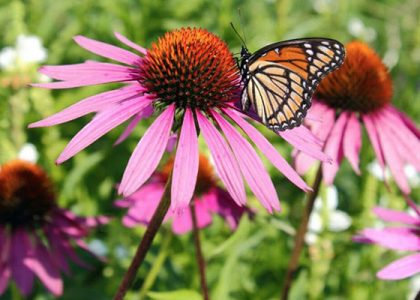 It’s that time of year when I’m scouting our butterfly nectar beds and corridors for the elusive Monarch, our Alabama state insect! When I see one, like I did last week and again today, I know they are on the move and that fall migration is underway! During the fall months hundreds of millions of Monarch butterflies are moving south for their annual fall migration to a remote oyamel fir tree forest west of Mexico City, MX where they will spend the winter. Less than ten years ago the winter butterfly population covered 45 acres of forested land, but that number has declined down to as low as 1 ½ acres with a rebound to less than 10 acres in 2015. While the Monarch is not considered a keystone species it does live an incredible life with an astounding migration experience as two to four generations of the butterflies migrate north to spend the summer months in Canada only to miraculously find its way from Canada to Mexico in the fall where it can live up to 9 months!
It’s that time of year when I’m scouting our butterfly nectar beds and corridors for the elusive Monarch, our Alabama state insect! When I see one, like I did last week and again today, I know they are on the move and that fall migration is underway! During the fall months hundreds of millions of Monarch butterflies are moving south for their annual fall migration to a remote oyamel fir tree forest west of Mexico City, MX where they will spend the winter. Less than ten years ago the winter butterfly population covered 45 acres of forested land, but that number has declined down to as low as 1 ½ acres with a rebound to less than 10 acres in 2015. While the Monarch is not considered a keystone species it does live an incredible life with an astounding migration experience as two to four generations of the butterflies migrate north to spend the summer months in Canada only to miraculously find its way from Canada to Mexico in the fall where it can live up to 9 months!
Sometime during the 1930’s a young boy in Canada became fascinated by the disappearance in the fall and spring time reappearance of the Monarch butterfly. He spent nearly 40 years, along with his wife, unraveling the mystery of the Monarch, finally discovering late in life, that Monarchs are able to suspend reproduction and store fat to migrate up to 3,000 miles. For a tiny creature known to complete its entire life cycle in a mere six weeks living for up to nine months over wintering in Mexico is simply incredible!
 So, what do scientists think is causing the decline of Monarch populations and what can we do to help? There are many reasons, including winter habitat destruction, but I’ve focused on one possible reason. As the butterflies travel northbound in the spring they need to stop along the way, mate and reproduce and this requires the specific host plant, milkweed, to be readily available! In the recent past milkweed plants thrived along the outer rows surrounding crops of corn and soybeans, but with the introduction of herbicide resistant crops, milkweed is being irradiated during routine spraying, causing a dire situation for the migrating Monarchs. The female Monarch must lay her eggs on a milkweed plant because that is what her host specific caterpillars will eat. No milkweed, no caterpillars; no caterpillars, no adults; no adults, no eggs and the lifecycle is broken. When traveling in the fall the adults need nectar sources, like the purple coneflower shown in the photograph. We’ve filled our nectar gardens at HBG with annuals and native perennials and you can do the same at your house! Got Milkweed?
So, what do scientists think is causing the decline of Monarch populations and what can we do to help? There are many reasons, including winter habitat destruction, but I’ve focused on one possible reason. As the butterflies travel northbound in the spring they need to stop along the way, mate and reproduce and this requires the specific host plant, milkweed, to be readily available! In the recent past milkweed plants thrived along the outer rows surrounding crops of corn and soybeans, but with the introduction of herbicide resistant crops, milkweed is being irradiated during routine spraying, causing a dire situation for the migrating Monarchs. The female Monarch must lay her eggs on a milkweed plant because that is what her host specific caterpillars will eat. No milkweed, no caterpillars; no caterpillars, no adults; no adults, no eggs and the lifecycle is broken. When traveling in the fall the adults need nectar sources, like the purple coneflower shown in the photograph. We’ve filled our nectar gardens at HBG with annuals and native perennials and you can do the same at your house! Got Milkweed?
Become a Citizen Scientist and submit your Monarch observations to:

